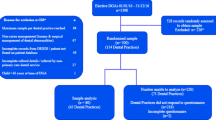Abstract
Aim: To determine who accompanies paediatric dental patients to their appointments, in a teaching hospital setting. Study Design: Data were recorded prospectively for children attending the Paediatric Dentistry clinic of the Charles Clifford Dental Hospital, Sheffield, England, over 4 months which included two school holiday periods. The data were recorded on a standardised data collection sheet, which included age and gender of the patient; number/s of accompanying adults and children and their relationship to the patient; the appointment session and appointment type. Results: A total of 394 paediatric dental visits were recorded. Patients were of a mean age of 10 (range 1–17 years). Most visits were for treatment (44.7%) and review (39.8%), with a much smaller proportion being new patient assessments (8.9%) and emergency appointments (6.6%). The numbers of afternoon and morning sessions recorded were approximately similar and 35% of the visits were recorded in a school holiday day. The majority of patients attended with at least one parent (91.6%). A parent was most likely to attend a new patient assessment (97.1%) or review visit (94.3%). Parental presence was less likely for treatment (89%) and least likely for emergency visits (84%). Most patients attended with their mother (62.1 %). Patients were less frequently accompanied by parents (13.1%), their father (12.1%) and one or both grandparents (4.3%). Smaller proportions were accompanied by older siblings, a step parent, other relatives or foster carers. Two patients attended unaccompanied. The time of day, or whether it was a school holiday period or not, did not influence parental presence or the numbers of adults accompanying patients. However the additional presence of other children (non patients) was more likely on morning sessions and during school holidays. Statistics: One way analysis of variance (ANOVA), an independent sample t-test or chi-squared tests were undertaken as appropriate to determine whether there were any significant differences in parental or child accompaniment according to the patient’s age; gender; type of appointment or time of appointment. Significance levels were set at P<0.05. Conclusions: It was of concern that a parent was least likely to accompany a child for an emergency visit when a history and consent may assume the greatest importance.
Similar content being viewed by others
References
American Academy of Pediatric Dentistry, Council on Clinical Affairs. Guideline on record-keeping. Pediatr Dent 2005–2006; 27(7 reference manual): 176–181.
American Academy of Pediatric Dentistry, Council on Clinical Affairs. Clinical guideline on informed consent. Pediatr Dent 2006; 28(suppl): 198–199.
Crossley ML, Joshi G. An investigation of paediatric dentists attitudes towards parental accompaniment and behavioural management techniques in the UK. Br Dent J 2002; 192(9): 517–521.
Crowley E, Whelton H, O’Mullane, et al. Parents preference as to whether they would like to accompany their child when receiving dental treatment-results from a national survey. J Ir Dent Assoc 2005; 51(1): 23–24.
Crowley E, Whelton H, O’Mullane, et al. Parents preference as to whether they would like to accompany their child when receiving dental treatment-results from a national survey. J Ir Dent Assoc 2005; 51(1): 23–24.
Dept of Health UK. Seeking consent: working with children. HMSO, London, 2001.
Diamond B. Legal aspects of consent 8: children under the age of 16 years. Br Nurs J 2001; 10(12): 797–799.
Fenlon WL, Dabbs AR, Curzon MEJ. Parental presence during treatment of the child patient. Br Dent J 1993; 174:23–28
Kain ZN, Fernandez LA, Touloukian RJ. Parental presence during induction of anaesthesia: the surgeon’s perspective. Eur J Pediatr Surg 1996a; 6(6): 323–327.
Kain ZN, Ferris CA, Mayes LC, Rimar S. Parental presence during induction of anaesthesia: practice differences between the United States and Great Britain. Paediatr Anaesth 1996b; 6(3): 187–193.
Klein H. Psychological effects of dental treatment on children of different ages. J Dent Child 1967; 34(1): 30–36.
Kurz R, Gill D, Mjones S. Ethical issues in the daily medical care of children. EurJ Paediatr 2005. DOI: 10.1007/s00432-005-0002-2.
Marzo G, Camanella V, Albani F, Gallusi G. Psychological aspects in paediatric dentistry: parental presence. Eur J Paediatr Dent 2003; 4(4): 177–180.
Moores A, Pace NA. Children’s rights in Europe. Eur J Anaesthesiol 2005; 22: 245–248.
Author information
Authors and Affiliations
Corresponding author
Rights and permissions
About this article
Cite this article
Virdee, P.K., Rodd, H.D. Who accompanies children to a dental hospital appointment?. Eur Arch Paediatr Dent 8, 96–98 (2007). https://doi.org/10.1007/BF03262576
Published:
Issue Date:
DOI: https://doi.org/10.1007/BF03262576




